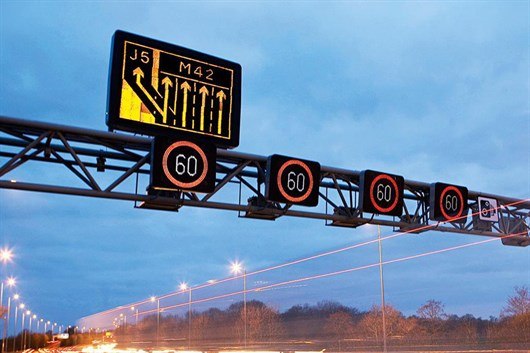Motorists warned to only use main roads if ‘necessary’ as National Highways workers strike

- Traffic officers and control centre staff at National Highways will be taking part in 12 days of strike action.
- Strikes begin in the north of England on 16 December, 2022, with final strike action on 6-7 January 2023.
- Road safety charity "very concerned" about impact on motorists.
Motorists are being advised to only use main roads if ‘necessary’ during the planned 12 day strikes by workers at National Highways, which is responsible for England’s motorways and major (trunk) roads.
The industrial action, which has been organised by the Public and Commercial Services Union (PCS), is due to start tomorrow, 16 December 2022, initially with National Highways workers in the north west, Yorkshire and the Humber and the north east striking for two days. This will be followed by workers in the London and the south east from 22 December to 25 December, the West Midlands and south west from 30 December to 31 December.
A two-day national strike will take place with all traffic officer service employees at all National Highways workplaces on 3 and 4 January 2023. This will be followed by workers in the East Midlands and eastern areas striking on 6-7 January 2023.
The industrial action is part of a wider dispute by public sector workers over working conditions and pay, with an estimated total of 1.3 million people striking in December, including ambulance workers, nurses, rail staff, Royal Mail staff, driving examiners and members of the Border Force.

Independent road safety charity, IAM RoadSmart is urging people to only travel on main roads in England if necessary, and check their vehicle before their journey. It suggested that “limited support on the highways could put lives at risk”.
Neil Greig, director of policy and research at IAM RoadSmart, said: “We are very concerned about these strikes. Control centre staff monitor information from traffic detectors and CCTV, and act on it to set the warning signs - they are often the first point of call when there is an incident.
“Having the right support there to act fast is absolutely critical on motorways, as any delays in setting signs or sending help could prolong someone being stranded on the side of a motorway, which can be life-threatening – even a few minutes can make the difference between getting involved in a collision or not.
“We want all drivers to be aware of the issue and, if they have to travel, to take as much care as they can on the roads – this is even more important when the road strikes coincide with severe weather and rail strikes. It has never been more important to make sure you have checked that your vehicle is safe, fuelled and prepared for any challenge.”

"We are confident that the impact of the strikes will be managed" Highways England
National Highways said that it is “working to ensure that any industrial action will not affect road users’ experience and are confident that the impact of the strikes will be managed”.
Around 125 out of 1,500 frontline operational staff – traffic officers on the road and in control rooms – will be taking part, it said. This equates to between 10 and 25 people per region.
The strike action does not include National Highways workers in a range of other roles, including those who work on the network every day to maintain road surfaces, signs and signals.
Separately, National Highways will be lifting roadworks around the country over the Christmas period (as it does) each year which, it said “will help to improve the flow of journeys on the network”.
Duncan Smith, executive director of operations at National Highways, said: “We’ve reviewed the impact that the PCS strikes may have and are confident our well-rehearsed resilience plans mean we can continue to manage and operate our network safely.
“Millions of people rely on our roads and there is a possibility that they may be busier than usual on strike days, particularly when they correspond with industrial action on other transport modes. We’d urge drivers to take extra care during the cold weather and in the run up to Christmas when our network is always busier.”
When are the National Highways road strikes happening?
National Highways workers in the north west, Yorkshire and Humber and the north east will strike on 16-17 December 2022.
Those in London and the south east will strike from 22-25 December 2022, followed by the West Midlands and south west from 30-31 December 2022.
In January 2023, workers in the East Midlands and eastern areas will strike from 6-7 January, with a national two-day strike taking place from 3-4 January.
How many National Highways workers are striking?
Around 125 out of 1,500 frontline operational National Highways staff – traffic officers on the road and in control rooms – will be taking part. This equates to between 10 and 25 people per region, National Highways said.
Which engine should I choose for high motorway mileage?

Why don't National Highways educate drivers about motorways and the left lane?


